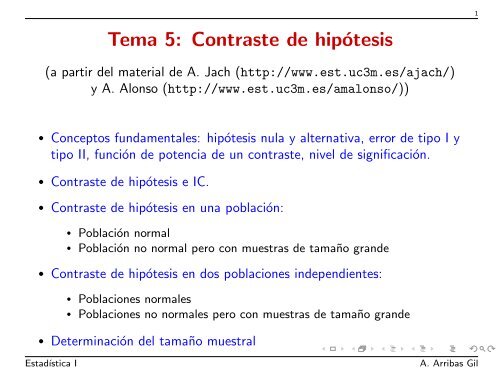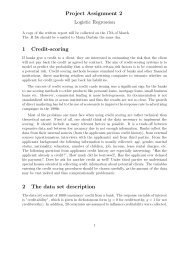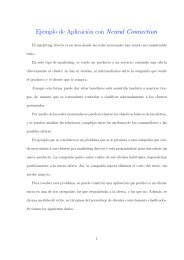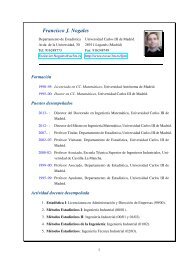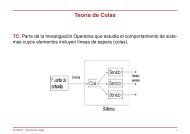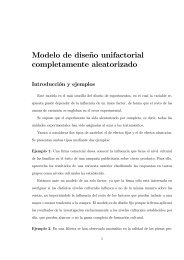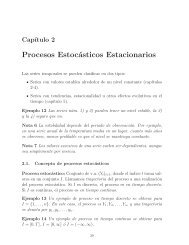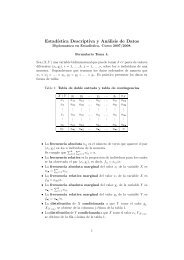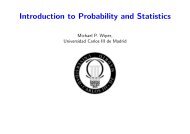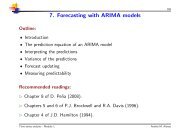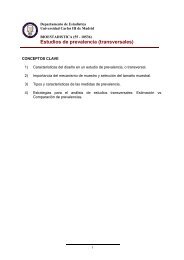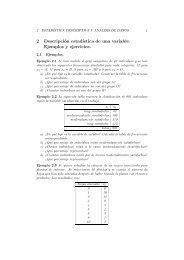Tema 5: Contraste de hipótesis
Tema 5: Contraste de hipótesis
Tema 5: Contraste de hipótesis
Create successful ePaper yourself
Turn your PDF publications into a flip-book with our unique Google optimized e-Paper software.
<strong>Tema</strong> 5: <strong>Contraste</strong> <strong>de</strong> hipótesis<br />
1<br />
(a partir <strong>de</strong>l material <strong>de</strong> A. Jach (http://www.est.uc3m.es/ajach/)<br />
y A. Alonso (http://www.est.uc3m.es/amalonso/))<br />
• Conceptos fundamentales: hipótesis nula y alternativa, error <strong>de</strong> tipo I y<br />
tipo II, función <strong>de</strong> potencia <strong>de</strong> un contraste, nivel <strong>de</strong> significación.<br />
• <strong>Contraste</strong> <strong>de</strong> hipótesis e IC.<br />
• <strong>Contraste</strong> <strong>de</strong> hipótesis en una población:<br />
• Población normal<br />
• Población no normal pero con muestras <strong>de</strong> tamaño gran<strong>de</strong><br />
• <strong>Contraste</strong> <strong>de</strong> hipótesis en dos poblaciones in<strong>de</strong>pendientes:<br />
• Poblaciones normales<br />
• Poblaciones no normales pero con muestras <strong>de</strong> tamaño gran<strong>de</strong><br />
• Determinación <strong>de</strong>l tamaño muestral<br />
Estadística I<br />
A. Arribas Gil
2<br />
Definición 1.<br />
Hipótesis estadísticas<br />
Una hipótesis estadística (H) es una proposición acerca <strong>de</strong> una característica<br />
<strong>de</strong> la población <strong>de</strong> estudio. Por ejemplo: “la variable X toma valores en el<br />
intervalo (a, b)”, “el valor <strong>de</strong> θ es 2”, “la distribución <strong>de</strong> X es normal”, etc.<br />
Ejemplo 1.<br />
• Una compañía recibe un gran cargamento <strong>de</strong> piezas. Sólo acepta el envío<br />
si no hay más <strong>de</strong> un 5% <strong>de</strong> piezas <strong>de</strong>fectuosas. ¿Cómo tomar una <strong>de</strong>cisión<br />
sin verificar todas las piezas<br />
• Se quiere saber si una propuesta <strong>de</strong> reforma legislativa es acogida <strong>de</strong> igual<br />
forma por hombres y mujeres ¿Cómo se pue<strong>de</strong> verificar esa conjetura<br />
Estos ejemplos tienen algo en común:<br />
• Se formula la hipótesis sobre la población.<br />
• Las conclusiones sobre la vali<strong>de</strong>z <strong>de</strong> la hipótesis se basarán en la<br />
información <strong>de</strong> una muestra.<br />
Estadística I<br />
A. Arribas Gil
Tipos <strong>de</strong> hipótesis estadísticas<br />
• Hipótesis paramétricas: Una hipótesis paramétrica es una proposición<br />
sobre los valores que toma un parámetro.<br />
3<br />
• Hipótesis simple: aquella que especifica un único valor para el parámetro.<br />
Ejemplos: ‘H : θ = 0”, “H : θ = −23”, etc.<br />
• Hipótesis compuesta: aquella que especifica un intervalo <strong>de</strong> valores para el<br />
parámetro.<br />
Ejemplos: ‘H : θ ≥ 0”, “H : 1 ≤ θ ≤ 4”, etc.<br />
Hipótesis unilateral: “H : θ ≤ 4”, ‘H : 0 < θ”, etc.<br />
Hipótesis bilateral: “H : θ ≠ 4 ⇔ H : θ < 4 y θ > 4”<br />
• Hipótesis no paramétricas: Una hipótesis no paramétrica es una<br />
proposición sobre cualquier otra característica <strong>de</strong> la población.<br />
Ejemplos: “H : X ∼ N”, “H : X ind. Y ”, etc. (<strong>Tema</strong> 6)<br />
Estadística I<br />
A. Arribas Gil
4<br />
Definición 2.<br />
Hipótesis nula y alternativa<br />
Llamamos hipótesis nula, y la representamos por H 0 , a la hipótesis que se<br />
<strong>de</strong>sea contrastar. Es la hipótesis que se plantea en primer lugar y la hipótesis<br />
que mantendremos a no ser que los datos indiquen su falsedad.<br />
Llamamos hipótesis alternativa, y la representamos por H 1 , a la negación <strong>de</strong> la<br />
hipótesis nula.<br />
Ejemplo 2.<br />
En cursos pasados, el número medio <strong>de</strong> préstamos por año y por alumno en la<br />
biblioteca <strong>de</strong> la Carlos III ha sido <strong>de</strong> 6. Este año la biblioteca ha hecho una<br />
campaña <strong>de</strong> información y quiere saber el efecto que ésta ha tenido entre los<br />
estudiantes.<br />
¿Cuáles serían las hipótesis nula y alternativa en este caso<br />
Estadística I<br />
A. Arribas Gil
5<br />
Definición 2.<br />
Hipótesis nula y alternativa<br />
Llamamos hipótesis nula, y la representamos por H 0 , a la hipótesis que se<br />
<strong>de</strong>sea contrastar. Es la hipótesis que se plantea en primer lugar y la hipótesis<br />
que mantendremos a no ser que los datos indiquen su falsedad.<br />
Llamamos hipótesis alternativa, y la representamos por H 1 , a la negación <strong>de</strong> la<br />
hipótesis nula.<br />
Ejemplo 2.<br />
En cursos pasados, el número medio <strong>de</strong> préstamos por año y por alumno en la<br />
biblioteca <strong>de</strong> la Carlos III ha sido <strong>de</strong> 6. Este año la biblioteca ha hecho una<br />
campaña <strong>de</strong> información y quiere saber el efecto que ésta ha tenido entre los<br />
estudiantes.<br />
¿Cuáles serían las hipótesis nula y alternativa en este caso<br />
H 0 : µ = 6 H 1 : µ > 6<br />
Estadística I<br />
A. Arribas Gil
6<br />
Definición 3.<br />
<strong>Contraste</strong> <strong>de</strong> hipótesis<br />
Un contraste <strong>de</strong> hipótesis es una regla que <strong>de</strong>termina, a un cierto nivel <strong>de</strong><br />
significación, α, para qué valores <strong>de</strong> la muestra se rechaza o no se rechaza la<br />
hipótesis nula.<br />
Es <strong>de</strong>cir, un contraste <strong>de</strong> hipótesis es una partición <strong>de</strong>l espacio muestral en dos<br />
regiones, una región crítica o <strong>de</strong> rechazo, RC, y una región <strong>de</strong> aceptación, RA.<br />
Ω = RC ∪ RA<br />
RC ∩ RA = ∅<br />
Ejemplo 2 (cont.)<br />
Hemos tomado una m.a.s. <strong>de</strong> 100 alumnos y obtenemos x = 6.23, s = 2.77.<br />
¿Cuál será la región crítica para el contraste H 0 : µ = 6 H 1 : µ > 6<br />
Sea X = “número <strong>de</strong> libros prestados por alumno y por año”.<br />
E[X ] = µ, Var[X ] = σ 2 ambas <strong>de</strong>sconocidas.<br />
Si H 0 fuera cierta, como n es gran<strong>de</strong>, sabemos que X − 6<br />
S/ √ n<br />
A<br />
∼ N(0, 1).<br />
Estadística I<br />
A. Arribas Gil
Ejemplo 2 (cont.)<br />
Escribiremos<br />
X − 6<br />
S/ √ n<br />
Es <strong>de</strong>cir, si H 0 fuera cierta,<br />
<strong>Contraste</strong> <strong>de</strong> hipótesis<br />
A<br />
∼<br />
H 0<br />
N(0, 1).<br />
(<br />
1 − α = P<br />
X −6<br />
S/ √ n < z α<br />
Por tanto, al nivel <strong>de</strong> significación α,<br />
RC α = {x 1 , . . . , x n | x − 6<br />
s/ √ n > z α} RA α = Ω\RC α = {x 1 , . . . , x n | x − 6<br />
s/ √ n ≤ z α}<br />
Para los datos <strong>de</strong>l ejemplo, n = 100, x = 6.23, s = 2.77, el valor <strong>de</strong>l<br />
estadístico <strong>de</strong>l contraste en nuestra muestra particular es:<br />
x − 6<br />
s/ √ n = 6.23 − 6<br />
2.77/10 = 0.8303<br />
Si consi<strong>de</strong>remos un nivel <strong>de</strong> significación igual a 0.05, tenemos que<br />
x−6<br />
s/ √ n = 0.8303 < 1.645 = z 0.05, es <strong>de</strong>cir, nuestra muestra particular no<br />
pertenece a la RC 0.05 , y por tanto, al nivel <strong>de</strong> significación 0.05, no<br />
rechazamos la hipótesis nula.<br />
Estadística I<br />
)<br />
.<br />
7<br />
A. Arribas Gil
Tipos <strong>de</strong> errores en un contraste <strong>de</strong> hipótesis<br />
Estado real<br />
8<br />
Decisión H 0 cierta H 0 falsa<br />
Error <strong>de</strong> Tipo I<br />
Decisión correcta<br />
Rechazar H 0 P(Rech.|H 0cierta) = α P(Rech.|H 0falsa) = 1 − β<br />
nivel <strong>de</strong> significación<br />
potencia<br />
No rechazar H 0 Decisión correcta Error <strong>de</strong> Tipo II<br />
P(No Rech.|H 0cierta) = 1 − α P(No Rech.|H 0falsa) = β<br />
1. Po<strong>de</strong>mos hacer la probabilidad <strong>de</strong>l error <strong>de</strong> tipo I tan pequeña como queramos,<br />
PERO esto hace que aumente la probabilidad <strong>de</strong>l error <strong>de</strong> tipo II.<br />
2. Un contraste <strong>de</strong> hipótesis pue<strong>de</strong> rechazar la hipótesis nula pero NO pue<strong>de</strong><br />
probar la hipótesis nula.<br />
3. Si no rechazamos la hipótesis nula, es porque las observaciones no han aportado<br />
evi<strong>de</strong>ncia para <strong>de</strong>scartarla, no porque sea neceseariamente cierta.<br />
4. Por el contrario, si rechazamos la hipótesis nula es porque se está<br />
razonablemente seguro (P(Rech.|H 0cierta) ≤ α) <strong>de</strong> que H 0 es falsa y estamos<br />
aceptando impĺıcitamente la hipótesis alternativa.<br />
Estadística I<br />
A. Arribas Gil
Definición 4.<br />
Nivel crítico o p-valor<br />
El nivel crítico, p, o p-valor es el nivel <strong>de</strong> significación más pequeño para el que<br />
la muestra particular obtenida obligaría a rechazar la hipótesis nula. Es <strong>de</strong>cir:<br />
p = P(Rech.H 0 para x 1 , . . . , x n |H 0 cierta)<br />
Es <strong>de</strong>cir, si T (X 1 , . . . , X n ) es el estadístico <strong>de</strong>l contraste:<br />
RC α = {x 1 , . . . , x n | T (x 1 , . . . , x n ) > T α }<br />
RC α = {x 1 , . . . , x n | T (x 1 , . . . , x n ) < T 1−α }<br />
RC α = {x 1 , . . . , x n | |T (x 1 , . . . , x n )| > T α }<br />
=⇒ p = P (T (X 1 , . . . , X n ) > T (x 1 , . . . , x n ))<br />
=⇒ p = P (T (X 1 , . . . , X n ) < T (x 1 , . . . , x n ))<br />
=⇒ p = P (|T (X 1 , . . . , X n )| > |T (x 1 , . . . , x n )|)<br />
9<br />
Estadística I<br />
A. Arribas Gil
Nivel crítico o p-valor<br />
Ejemplo 2 (cont.) Para los datos <strong>de</strong>l ejemplo, n = 100, x = 6.23, s = 2.77,<br />
al nivel <strong>de</strong> significación 0.05, no rechazamos la hipótesis nula. ¿Cuál es el<br />
p-valor para esta muestra (RC α = {x 1 , . . . , x n | x−6<br />
s/ √ n > z α})<br />
El nivel crítico o p-valor es el nivel <strong>de</strong> significación más pequeño para el que la<br />
muestra particular obtenida obligaría a rechazar la hipótesis nula:<br />
x 1 , . . . , x n ∈ RC ⇔ x − 6<br />
s/ √ n = z p<br />
⇔ z p = x − 6<br />
s/ √ n = 6.23 − 6<br />
2.77/10 = 0.8303<br />
⇔ p = 0.2033<br />
O equivalentemente,<br />
(<br />
)<br />
X −6<br />
p = P(Rech.|H 0 cierta) = P<br />
S/ √ n > x−6<br />
s/ √ n |H 0cierta<br />
Z= X −6<br />
S/ √ H<br />
∼N(0,1) 0<br />
n<br />
= P(Z > 6.23−6<br />
2.77/10<br />
) = P(Z > 0.8303) = 0.2033<br />
10<br />
Estadística I<br />
A. Arribas Gil
Metodología<br />
11<br />
Método <strong>de</strong> construcción <strong>de</strong> un contraste <strong>de</strong> hipótesis paramétrico al nivel <strong>de</strong><br />
significación α:<br />
1. Plantear las hipótesis nula y alternativa (“H 0 : θ = θ 0 , H 1 : θ ≠ θ 0 ”,<br />
“H 0 : θ = θ 0 , H 1 : θ < θ 0 ”,“H 0 : θ ≤ θ 0 , H 1 : θ > θ 0 ”, etc.)<br />
2. Determinar el estadístico <strong>de</strong>l test, T (X 1 , . . . , X n ), y su distribución bajo<br />
H 0 (Formulario).<br />
3. Dos posibilida<strong>de</strong>s:<br />
3.a Construir la región crítica y comprobar si la muestra obtenida está en ella<br />
(rechazamos H 0) o no (no rechazamos H 0).<br />
3.b Calcular el p-valor para la muestra obtenida. Si p < α, se rechaza H 0.<br />
4. Plantear las conclusiones.<br />
Estadística I<br />
A. Arribas Gil
12<br />
<strong>Contraste</strong> <strong>de</strong> hipótesis e IC’s<br />
El contraste <strong>de</strong> una hipótesis nula simple frente a una alternativa bilateral<br />
H 0 : θ = θ 0 H 1 : θ ≠ θ 0<br />
al nivel <strong>de</strong> significación α, es equivalente a construir un IC al (1 − α)100%<br />
para θ, y a partir <strong>de</strong> él tomar la siguiente <strong>de</strong>cisión:<br />
• rechazar H 0 si θ 0 está fuera <strong>de</strong>l IC.<br />
• no rechazar H 0 si θ 0 está en el IC.<br />
Es <strong>de</strong>cir IC (1−α)100% (θ) = RA α .<br />
Ejemplo 3.<br />
Supongamos que la altura (en cm) <strong>de</strong> los estudiantes <strong>de</strong> la UC3M es una v.a.<br />
X con distribución N(µ, 5). Con el objetivo <strong>de</strong> estimar µ se toma una m.a.s.<br />
<strong>de</strong> 100 estudiantes y se obtiene x = 156.8. (Ejemplo 1 <strong>Tema</strong> 4)<br />
Se quiere contrastar la siguiente hipótesis sobre esta población: “la altura<br />
media <strong>de</strong> los estudiantes <strong>de</strong> la UC3M es <strong>de</strong> 160cm” al nivel <strong>de</strong> significación<br />
0.05.<br />
Estadística I<br />
A. Arribas Gil
13<br />
<strong>Contraste</strong> <strong>de</strong> hipótesis e IC’s<br />
Ejemplo 3 (cont.)<br />
Seguimos los pasos <strong>de</strong> la metodología para la construcción <strong>de</strong> contrastes:<br />
1. Plantear las hipótesis nula y alternativa:<br />
H 0 : µ = 160 H 1 : µ ≠ 160<br />
2. Determinar el estadístico <strong>de</strong>l test y su distribución bajo H 0 (Formulario).<br />
X ∼ N(µ, 5), por tanto<br />
X − µ<br />
5/ √ n<br />
∼ N(0, 1) ⇒<br />
X − 160<br />
5/ √ n<br />
H 0<br />
∼ N(0, 1)<br />
Estadística I<br />
A. Arribas Gil
<strong>Contraste</strong> <strong>de</strong> hipótesis e IC’s<br />
Ejemplo 3 (cont.)<br />
14<br />
3.a Construir la región crítica y comprobar si la muestra obtenida está en ella<br />
(rechazamos H 0 ) o no (no rechazamos H 0 ). Sabemos que bajo H 0<br />
Por tanto<br />
RC α =<br />
(<br />
1 − α = P −z α < X − 160 )<br />
2<br />
5/ √ n < z α<br />
2<br />
{<br />
x 1 , . . . , x n |<br />
RA α = Ω\RC α =<br />
∣<br />
∣ x−160<br />
5/ √ n<br />
∣ > z α<br />
2<br />
{<br />
x 1 , . . . , x n |<br />
Recor<strong>de</strong>mos que el IC al (1 − α)100% para µ era<br />
160 ∈IC ⇔ x−z α<br />
2<br />
5<br />
√ n<br />
≤ 160 ≤ x+z α<br />
2<br />
∣<br />
}<br />
∣ x−160<br />
5/ √ n<br />
5<br />
√ n<br />
⇔ |x−160| ≤ z α<br />
2<br />
∣ ≤ z α<br />
2<br />
(<br />
x ± z α<br />
2<br />
}<br />
5 √ n<br />
):<br />
5<br />
√ n<br />
⇔ x 1 , . . . , x n ∈RA α<br />
Estadística I<br />
A. Arribas Gil
<strong>Contraste</strong> <strong>de</strong> hipótesis e IC’s<br />
15<br />
Ejemplo 3 (cont.)<br />
Para α = 0.05 (n = 100, x = 156.8):<br />
∣ x − 160<br />
∣ 5/ √ ∣∣∣ n ∣ = 156.8 − 160<br />
5/10 ∣ = |−3.2| = 3.2 y z α = 1.96<br />
2<br />
es <strong>de</strong>cir x 1 , . . . , x n ∈ RC 0.05 ⇒ rechazamos H 0 al nivel <strong>de</strong> significación 0.05.<br />
O equivalentemente, a partir <strong>de</strong>l IC al 95% para µ:<br />
( ) (<br />
5<br />
x ± z α √ = 156.8 ± 1.96 5 )<br />
= (155.82, 157.78)<br />
2 n 10<br />
160 /∈ IC 95% (µ) ⇒ rechazamos H 0 al nivel <strong>de</strong> significación 0.05.<br />
Hemos comprobado que es equivalente realizar el contraste al 0.05% a<br />
encontrar el IC para µ al 95% y rechazar H 0 si µ 0 no está en él.<br />
Estadística I<br />
A. Arribas Gil
Ejemplo 3 (cont.)<br />
<strong>Contraste</strong> <strong>de</strong> hipótesis e IC’s<br />
16<br />
3.b (Otra alternativa) Calcular el p-valor para la muestra obtenida.<br />
p = P(Rech.H 0 para x 1 , . . . , x n |H 0 cierta)<br />
(∣ )<br />
∣∣ X −160<br />
= P<br />
5/ √ n<br />
∣ > ∣ x−160<br />
5/ √ n<br />
∣ |H 0 cierta<br />
Z= X −160<br />
5/ √ H<br />
∼N(0,1) 0 (<br />
)<br />
n<br />
= P |Z| > ∣ 156.8−160<br />
∣ = P(|Z| > 6.4) = 2 · P(Z > 6.4) ≈ 0<br />
5/10<br />
El p-valor obtenido es menor que α (p ≈ 0
17<br />
<strong>Contraste</strong> <strong>de</strong> hipótesis en una población<br />
Sea X una v.a. cuya distribución <strong>de</strong>pen<strong>de</strong> <strong>de</strong> θ. X 1 , . . . , X n m.a.s. <strong>de</strong> X .<br />
Sea T (X 1 , . . . , X n ) el estadístico <strong>de</strong>l contraste }<br />
T (X 1 , . . . , X n ) H0<br />
∼ P 0<br />
y T α el cuantil α <strong>de</strong> P 0 .<br />
Formulario ∗<br />
H 0 H 1 RC α<br />
θ = θ 0 θ ≠ θ 0<br />
{<br />
x1 . . . , x n | |T (X 1 , . . . , X n )| > T α/2<br />
}<br />
θ ≤ θ 0 θ > θ 0 {x 1 . . . , x n | T (X 1 , . . . , X n ) > T α }<br />
θ ≥ θ 0 θ < θ 0 {x 1 . . . , x n | T (X 1 , . . . , X n ) < T 1−α ∗∗ }<br />
∗ Como siempre, dos casos posibles: X normal o X no normal pero n gran<strong>de</strong> (TCL).<br />
Hay que formular siempre TODAS las hipótesis necesarias.<br />
∗∗ Si P 0 es simétrica (normal o t-stu<strong>de</strong>nt), entonces T 1−α=−T α.<br />
Estadística I<br />
A. Arribas Gil
<strong>Contraste</strong> <strong>de</strong> hipótesis en dos poblaciones in<strong>de</strong>pendientes<br />
Sea X una v.a. cuya distribución <strong>de</strong>pen<strong>de</strong> <strong>de</strong> θ 1 . X 1 , . . . , X n1 m.a.s. <strong>de</strong> X .<br />
Sea Y una v.a. cuya distribución <strong>de</strong>pen<strong>de</strong> <strong>de</strong> θ 2 . Y 1 , . . . , Y n2 m.a.s. <strong>de</strong> Y .<br />
X e Y in<strong>de</strong>pendientes.<br />
Sea T (X 1:n1 , Y 1:n2 ) el estadístico <strong>de</strong>l contraste<br />
}<br />
T (X 1:n1 , Y 1:n2 ) H0<br />
∼ P 0<br />
y T α el cuantil α <strong>de</strong> la distribución <strong>de</strong> P 0 .<br />
Formulario ∗<br />
18<br />
H 0 H 1 RC α<br />
θ 1 − θ 2 = d ∗∗<br />
0 θ 1 − θ 2 ≠ d 0<br />
{<br />
x1:n1 , y 1:n2 | |T (X 1 , . . . , X n )| > T α/2<br />
}<br />
θ 1 − θ 2 ≤ d 0 θ 1 − θ 2 > d 0 {x 1:n1 , y 1:n2 | T (X 1 , . . . , X n ) > T α }<br />
θ 1 − θ 2 ≥ d 0 θ 1 − θ 2 < d 0 {x 1:n1 , y 1:n2 | T (X 1 , . . . , X n ) < T 1−α }<br />
∗ Como siempre, dos casos posibles: X , Y normales o X , Y no normales pero n<br />
gran<strong>de</strong> (TCL). Hay que formular siempre TODAS las hipótesis necesarias.<br />
∗∗ En general, en la comparación <strong>de</strong> varianzas d 0 = 0.<br />
Estadística I<br />
A. Arribas Gil
Definición 5.<br />
Determinación <strong>de</strong>l tamaño muestral<br />
La potencia o función potencia <strong>de</strong>l contraste paramétrico<br />
19<br />
H 0 : θ ∈ Θ 0 H 1 : θ ∈ Θ 1 = Θ\Θ 0<br />
se <strong>de</strong>fine como<br />
p(θ 1 ) = 1 − β(θ 1 ) = 1 − P(Error <strong>de</strong> Tipo II) = P(Rech. H 0 | H 0 falsa)<br />
= P(Rech. H 0 | θ = θ 1 ), ∀θ 1 ∈ Θ 1 .<br />
Ejemplo 3 (cont.)<br />
Para el contraste<br />
teníamos<br />
RC α =<br />
H 0 : µ = 160 H 1 : µ ≠ 160<br />
{<br />
x 1 , . . . , x n |<br />
∣<br />
x − 160<br />
5/ √ n<br />
∣ > z α<br />
2<br />
}<br />
.<br />
Estadística I<br />
A. Arribas Gil
Ejemplo 3 (cont.)<br />
Determinación <strong>de</strong>l tamaño muestral<br />
La función <strong>de</strong> potencia <strong>de</strong> este contraste es:<br />
20<br />
p(µ 1 ) = P(Rech. H 0 | µ = µ 1 ) = P<br />
( X − 160<br />
= P<br />
(∣ ∣∣∣ X − 160<br />
5/ √ n<br />
)<br />
∣ > z α | µ = µ<br />
2 1<br />
5/ √ n < −z α<br />
2<br />
o X − 160<br />
5/ √ n > z α<br />
2<br />
| µ = µ 1<br />
)<br />
(<br />
= P X < 160 − z α<br />
2<br />
( X − µ1<br />
[tipif.] = P<br />
[<br />
Z=<br />
X −µ 1<br />
5/ √ n<br />
]<br />
µ=µ<br />
∼ 1<br />
N(0,1)<br />
= P<br />
5/ √ n < 160 − µ 1<br />
5/ √ n<br />
5<br />
√ n<br />
o X > 160 + z α<br />
2<br />
)<br />
5<br />
√ | µ = µ 1 n<br />
− z α o X − µ 1<br />
2<br />
5/ √ n > 160 − µ 1<br />
5/ √ n<br />
+ z α<br />
2<br />
| µ = µ 1<br />
)<br />
(<br />
Z < 160 − µ 1<br />
5/ √ − z α o Z > 160 − µ )<br />
1<br />
2<br />
n<br />
5/ √ + z α , ∀µ<br />
2<br />
1 ≠ 160.<br />
n<br />
Estadística I<br />
A. Arribas Gil
Determinación <strong>de</strong>l tamaño muestral<br />
21<br />
Ejemplo 3 (cont.)<br />
¿Cómo es p(µ 1 ) en función <strong>de</strong> n<br />
¿Y en función <strong>de</strong> |µ 0 − µ 1 |<br />
Dada σ y prefijado el nivel <strong>de</strong> significación, el objetivo es obtener una potencia<br />
mayor o igual que un cierto valor (valores usuales 0.9 ó 0.8) cuando la<br />
diferencia entre la media verda<strong>de</strong>ra, µ 1 , y la hipotética, µ 0 , supere un valor<br />
prefijado.<br />
Buscaremos el tamaño <strong>de</strong> muestra mínimo que verifique esa condición.<br />
Estadística I<br />
A. Arribas Gil


